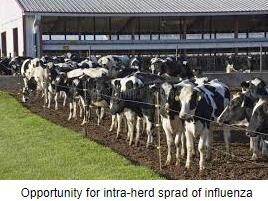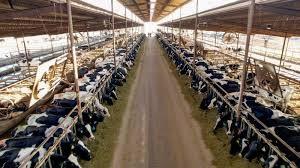 The USDA-APHIS has now confirmed H5N1 avian influenza virus in oropharyngeal swabs and in milk from dairy cows demonstrating clinical depression and reduced milk production. This is the second series of reported cases of H5N1 avian influenza in a ruminant following the goat herd in Minnesota reported last week.
The USDA-APHIS has now confirmed H5N1 avian influenza virus in oropharyngeal swabs and in milk from dairy cows demonstrating clinical depression and reduced milk production. This is the second series of reported cases of H5N1 avian influenza in a ruminant following the goat herd in Minnesota reported last week.
Dairy herds have been affected in Texas, New Mexico and Kansas. The condition emerged approximately three weeks ago but was not diagnosed until March 25th. Based on the presence of dead birds in the vicinity of the Texas farm, it is presumed that shedding by either migratory or resident birds introduced the infection.
State and federal authorities have been quick to note that there was no danger to the public. This assurance was based on the fact that milk from affected animals did not enter the market and that pasteurization would in any event destroy the virus. Perhaps the calming statements by USDA and state veterinarians are at this time appropriate but obvious concerns exist.
The brief report released by USDA-APHIS raises a number of questions: -
- What species of birds were found dead in the vicinity of implicated farms and has H5N1 virus been isolated from carcasses?
- Can H5N1 virus be isolated from clinically normal contact cows in the affected herds? Is animal-to-animal transmission taking place? Since as stated, ten percent of cows within the affected herds apparently demonstrated clinical signs, factors contributing to intra-herd transmission should be determined.
- Studies in progress should demonstrate the duration of viremia, infectivity and the presence of virus in milk.
- Is milk from clinically unaffected animals in the affected herds being withheld? The report indicated disposal of milk from affected animals. Obviously, clinical signs and milk production will indicate morbidity in individual animals. In the interest of safety and to preserve the wholesome image of milk, is it intended to withhold products from entire affected herds rather than individual animals and presumably until isolation from udder milk ceases?
- Will case control studies be conducted on affected and unaffected control herds to establish risk factors for the introduction of infection in a specific location?
- What changes in the H5N1 virus occurred to allow infection of ruminants? The USDA release noted, “Initial testing by the National Veterinary Service Laboratories has not found changes to the virus that would make it more transmissible to humans.” The report also stated that viral genome sequencing is in progress. Accordingly, is the comment regarding risk to human health valid? Isolates from dead farmed mink in Spain and marine mammals along the coast of Chile demonstrated mutations associated with infection of mammals.
- Is there evidence of H5N1 influenza virus in evaporative cooling systems, drains, manure handling, feed or other areas of the environment of the affected herd?
- Are hogs next to be affected by H5N1? This species is susceptible to both avian and mammalian strains of influenza virus and herds could serve as ‘mixing vessels” for recombinant strains of influenza virus with enhanced pathogenicity for livestock or humans.
It is hoped that appropriate resources can be applied to obtain a rapid understanding of the epidemiology of H5N1 infection in dairy cattle. This should include extensive surveillance in the three states concerned but also in other areas where outbreaks of H5N1 have been diagnosed in backyard flocks that serve as natural sentinels.

The track record of USDA-APHIS with regard to investigating the field epidemiology of HPAI in commercial egg-production and turkey flocks since the 2015 epornitic has been abysmal. Failure by APHIS to report on the molecular biology of H5N1 virus isolates of 2023 contrasts unfavorably with the prompt investigations and reports from health professionals in South America under the auspices of the Pan American Health Organization.
Currently there are too many questions and understandably at present insufficient answers. We trust that the CCC “slush fund” will be used by Secretary Vilsack to establish a task force to investigate the emergence of H5N1 in dairy herds and poultry flocks in order to provide valid and productive recommendations based on established scientific facts. In the interim there are millions of waterfowl about to begin their northward spring migration with 320 million egg production hens, 70 million pullets, 50 million growing turkeys, all susceptible to H5N1 and with a high proportion located in areas at risk for exposure. Preemptive strategic vaccination would appear prudent to create an immune commercial poultry population. If the 2023 and 2024 H5N1 virus can kill farmed mink and free-living marine mammals and some migratory bird species in their thousands and now to infect ruminants. How long will it be before it could become a zoonotic pathogen? This is a concern expressed by the World Health Organization since 2020 designating avian influenza as a potential pandemic infection and should be heeded by all involved in the “OneHealth” principle.